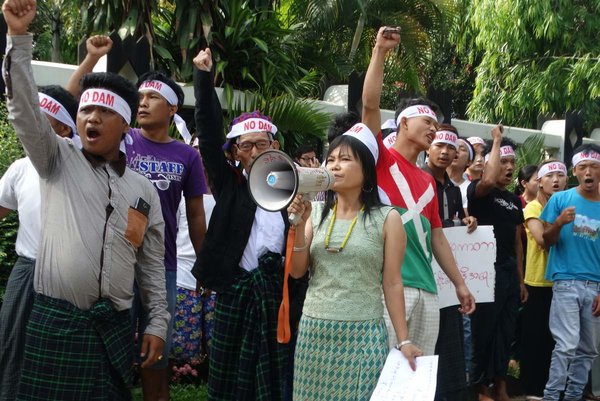A visit to the Kachin State capital by China’s ambassador was met on Saturday morning with protests by activists and environmentalists opposed to the stalled Myitsone mega-dam project. Dozens of demonstrators took part in an impromptu rally in front of the Palm Spring Resort Hotel in Myitkyina where Ambassador Hong Liang was staying.
A statement from protest organisers sent to DVB reiterated long-standing calls for the project to be cancelled permanently. “The NLD and Kachin State government should recognise Myanmar [Burmese] people’s’ voices and totally stop the Myitsone project,” said Tsa Ji of the Kachin Development Networking Group.
Media reports indicate that Ambassador Hong’s visit to Kachin State included meetings with government officials and a stopover at a relocation village comprising of residents who were forcibly displaced from their farms to make way for the hydropower project.
In an interview conducted with Frontier magazine just before the NLD took office, the Chinese ambassador suggested that the controversy over Myitsone could be solved if the benefits of the project were better understood by the public. “The Chinese government will discuss … what the benefits of this project are to the local people, and will discuss with local stakeholders and the next government,” he said.
His comments echoed that of his superiors in Beijing who have repeatedly criticised the suspension of the project. Speaking at press conference in March, China’s Vice Foreign Minister Liu Zhenmin responded to a question about by the dam by suggesting that going ahead with the project would be in the best interests of both countries. “Very regretfully, it [Myitsone dam] was shelved by the Myanmar government in 2011. But the contract is still in force. How to push this cooperation forward is an important thing for both countries,” he told a news conference. Similarly during a March press conference in Beijing, Foreign Minister Wang Yi referred to difficulties with the Myitsone project as “growing pains” that both China and Burma would manage.
The protestors however, and many other people in Kachin State, have a much different view of the project, which remains deeply unpopular throughout the country, with opponents saying it will irreversibly alter the flow of Burma’s longest river, the Irrawaddy, officially known as the Ayeyarwady.
The protest at the Palm Spring Hotel included a speech from the leader of the Kachin Democratic Party, Awng Hkam, a long-time Kachin environmentalist who during the previous military regime played a key role in mobilising an underground movement in Kachin State against the dam.
Protest organisers estimated that the turnout for the hastily arranged rally was more than 70 people, many of whom were residents of the relocation village at Tang Phre. The peaceful gathering was observed by a large contingent group of riot shield-yielding police.
Project still in limbo
In September 2011, President Thein Sein announced that he was officially suspending the building of the Myitsone dam, the largest of a series of seven hydropower projects slated to be built by a consortium led by Chinese Power International (CPI), a Chinese state-owned energy firm. CPI, who recently underwent a name change to State Power Investment Corporation, or SPIC, after merging with a state-owned nuclear power company, have since pressured Naypyidaw to allow it to resume building.
Last year CPI obtained the services of powerful lobbying firm Bell Pottinger in its bid to resurrect the three-billion-dollar project. The London-based company is known for its willingness to take on controversial clients, including the regime in Belarus, and the wife of Syrian dictator Bashir al-Assad.
[related]
The NLD, since taking office earlier this year, has said very little about its stance on the controversial project. While a 9 March article from AFP quoted the head of the NLD’s economics committee, Hantha Myint, as suggesting that the NLD government would implement a redesign of the project – a statement many saw as music directed at the ears of China’s mega-dam engineers – those long opposed to the dams on the Irrawaddy were not pleased. “If we refuse to build a dam at Myitsone, we can build other dams upstream,” said Hantha Myint. The trained engineer also told AFP that ultimately the final decision would be made by State Councillor Aung San Suu Kyi.
In addition to the NLD government’s dilemma on the fate of the project, exterior matters may also determine the dam’s future. The ongoing conflict between the Kachin Independence Organisation and the Burmese army, which reignited in June 2011, will likely pose serious barriers to the resumption of any local enterprise of such size and significance. The onset of armed clashes in much of the Kachin countryside in 2011 led to the destruction of a bridge that was used to transport goods on roads connecting China to Kachin State. Although a temporary replacement has been built, it is unable to withstand the weight of heavy trucks, which means that most goods, including heavy machinery, coming from China must be shipped on alternative routes, adding days of delay.



